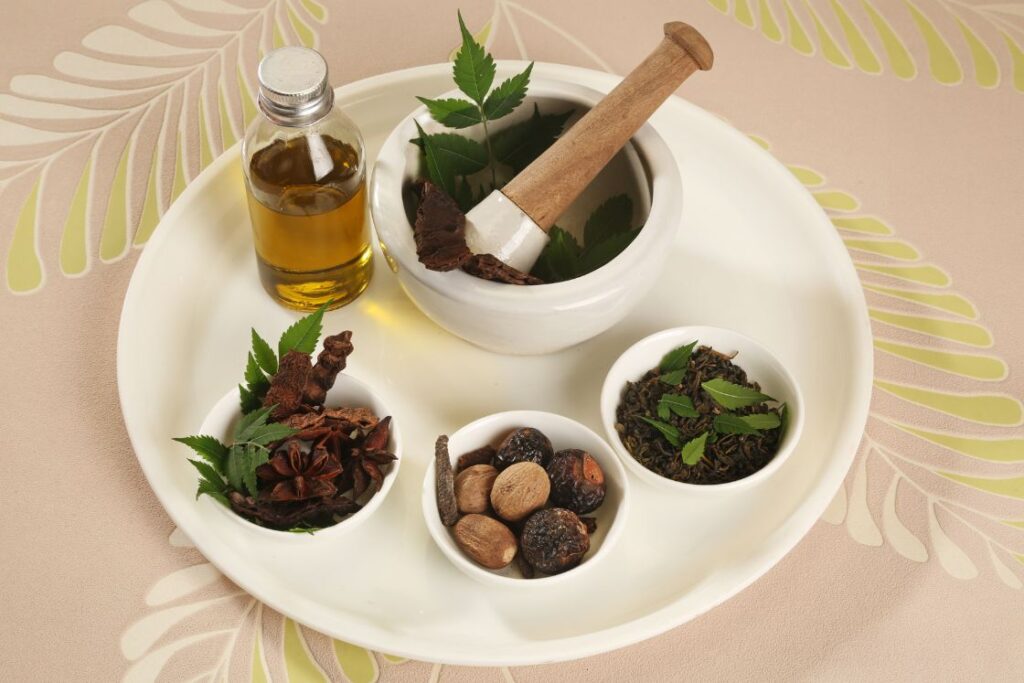- Kapha Body Type
- Imbalance Symptoms
- How to Balance Kapha
- Kapha Dosha Diet
- Ayurvedic herbs
- Oil massage
- Yoga and meditation
- Essential oils

Water and earth are the main elements that together form Kapha dosha. It includes the properties of both elements, including the fluidity, lubrication, and coolness of the water and the firmness, stability, and strength of the earth. Kapha is responsible for maintaining stability and balance in the body.
By combining these two elements, Kapha produces qualities such as heaviness, slowness, steadiness, firmness, coolness, softness, smoothness, oiliness, wetness, dullness, density, and fluidity.
The center of Kapha is located in the chest area, lungs, and throat. It plays an important role in the formation of various tissue types in the body.
A healthy kapha dosha contributes to better memory and sense of smell, improves mental and physical stability, aids in weight control, regulates sleep patterns and quality, nourishes the joints, and promotes compassionate, forgiving, and loving behavior. It also encompasses several other positive emotional qualities.
However, when Kapha levels become too high, it can lead to weight gain, fluid retention, and allergies. Unbalanced Kapha types may experience weight gain, excessive sleep, and conditions such as asthma, diabetes, and depression. Aversion to change and stubbornness are also psychological symptoms of excessive Kapha.
To prevent imbalance or restore overactive kapha, it is important to adjust your diet, use appropriate herbs and oils, perform massages, and make lifestyle changes.
What does a Kapha Body look like?

People with a preponderance of kapha dosha often have a pronounced physical appearance. They tend to be broad in stature and heavy in build. Their metabolism and digestion are typically slow, and they generally have a low to moderate appetite. They may have difficulty waking up in the morning, as they tend to sleep a lot. Their speech is deliberate and slow.
The influence of the water element on people with a Kapha dosha is evident in their physical features. They often have fair, cold skin that looks shiny and can be greasy. Kapha people usually have strong, coarse, and curly hair, while their eyes are usually dark and deep-set.
Cloudy weather and silence have a calming effect on the Kapha people. However, it may take some time for them to forgive and forget once they have been angered.
[contact-form-7]
In addition to their physical characteristics, Kapha individuals possess certain personality traits. They show exceptional attention to detail and a determined nature when it comes to pursuing their goals. They are naturally loving, calm, and considerate, and value contentment as one of the benefits of a healthy Kapha. They have an innate ability to enjoy life to the fullest and find satisfaction in routines.
When in harmony, Kapha individuals are known for their strength, dedication, patience, steadfastness, and supportive nature.
Symptoms of Kapha Doshs Imbalance
The main symptoms of Kapha include:
- Heavy – Feeling heavy and gaining weight is a common symptom of Kapha imbalance
- Chilly – Chills and cold sweats occur when there is an increase in the cool quality.
- Oily – Kapha usually complains of excessively oily skin and hair, enlarged pores, blackheads, and cystic acne when the balance is upset
- Damp – The problem of clammy skin can be a result of an increase in the damp aspect.
- Dull – Lethargy, sleepiness, laziness, depression, or lack of motivation are often noted from an unbalanced kapha body
- Fluid – An increase in fluid quality results in coughing, constipation, excessive phlegm, excessive salivation, water retention, swelling, and puffiness.
Other symptoms include:
- Allergies
- Slow digestion, constipation, diarrhea
- Loss of appetite
- Excessive sleepiness, difficulty rising in the morning
- The thick white tongue coat
- Attachment, greed, hoarding
- Stubbornness, Possessiveness
- Sadness, overly sentimental
- Emotional overeating
- Ignorance, Delusion
How to Balance Kapha Dosha
Eat light, warm, and dry foods with pungent, bitter, and astringent flavors

According to Ayurveda, Kapha dosha is associated with qualities such as heaviness, coldness, greasiness, and sluggishness. To balance these characteristics and speed up metabolism, the following dietary guidelines are recommended:
- Warm and prepared foods: Prefer warm, freshly cooked meals instead of cold or raw foods. Warm foods are easier to digest and stimulate the digestive and metabolic systems.
- Light and high-energy foods: choose light and high-energy foods that are less dense and light. Examples include apricots, berries, apples, watermelons and pears. These fruits can provide vitality and aid in digestion.
- Tea: Black and green teas can be beneficial because of their lightness. They can give a gentle boost of energy and aid digestion.
- Heat and seasoning: Use spices that provide warmth and spice to counteract the cold and heavy nature of kapha. Hot spices such as cayenne, chili, pepper, and ginger can be especially useful in aiding digestion and reducing kapha.
- Limit sweet and juicy vegetables: although all vegetables are generally recommended, it is advisable to limit the consumption of sweet and juicy vegetables such as sweet potatoes, tomatoes, and zucchini. These vegetables can contribute to the heaviness and dampness associated with kapha.
- Avoid rough and sugary fruits: fruits with a rough texture, such as oranges and bananas, should be avoided. Sugary fruits such as pineapple and coconut should also be consumed only in moderation, as they can harm rather than benefit Kapha.
- Reduce oil, ghee, and butter: Limit your intake of oils, ghee, and butter, as they can increase the oily quality of kapha. Use them sparingly in cooking or opt for lighter alternatives.
- Use salt sparingly: Salt should be used sparingly as it can aggravate kapha. Watch your salt consumption and use alternative seasonings to enhance the flavor of your meals.
- Avoid sour and sweet foods: Sour and sweet foods should be avoided as much as possible, as they can exacerbate kapha. Instead, focus on incorporating sharper and more bitter flavors into your meals.
Use Kapha Calming and Balancing Ayurvedic Herbs

- Ginger: Ginger has a warming effect and can help stimulate digestion, reduce congestion and promote detoxification. It is often used to treat Kapha-related problems such as obesity, poor digestion, and nasal congestion. Use ginger in your cooking, in teas, or drink ginger tea for its warming and stimulating properties.
- Turmeric: Turmeric is known for its detoxifying properties and effectively neutralizes excess kapha in the body-mind system. It has a bitter, pungent and astringent taste and a gentle warming effect. Turmeric can be added to curries, stews, smoothies or mixed with warm milk to make a healing drink.
- Triphala: Triphala is a traditional Ayurvedic herbal formula consisting of three fruits: Amalaki (Indian gooseberry), Bibhitaki and Haritaki. It supports digestion, detoxification and overall balance in the body. Triphala can be taken as a dietary supplement or infused in warm water and drunk as a tea.
- Holy Basil (Tulsi): Holy Basil, also known as Tulsi, is considered sacred in Ayurveda and has various medicinal properties. It has a warming effect and can help balance Kapha, reduce congestion, and support respiratory health. Enjoy Tulsi tea or add fresh Tulsi leaves to your meals.
- Coriander: Coriander seeds and leaves have a pungent and slightly bitter flavor. They can help stimulate digestion, reduce Kapha-related symptoms, and support detoxification. Use coriander seeds as a spice in cooking or add fresh coriander leaves to salads, soups, or smoothies.
- Ashwagandha: Ashwagandha is an adaptogenic herb that helps the body adapt to stress. It has a calming effect on the nervous system and can support overall balance. Ashwagandha can be taken as a supplement or added to warm milk or tea.
When using these herbs, it’s important to consider your individual constitution and any specific health conditions. It’s always recommended to consult with an Ayurvedic practitioner or healthcare professional for personalized guidance and dosages.
Indulge in Vigorous and Fluid Yoga Practices

- Warm, light and invigorating exercises: Opt for warm, light and invigorating yoga exercises to balance the heaviness and sluggishness associated with kapha. These exercises can help invigorate energy flow and provide a sense of freshness and vitality. Dynamic and flowing styles such as vinyasa or power yoga may be appropriate for kapha types.
- Emphasize flexibility and endurance: Although Kapha body types tend to be more robust, they can still benefit from improving flexibility. Incorporate yoga poses that focus on stretching and opening the body, such as backbends, hip openers and twists. Balance poses that challenge stability can also be beneficial.
- Minimize transition time: Kapha types may benefit from minimizing the transition time between poses to maintain a steady flow and keep energy levels high. This can help avoid stagnation and keep the practice engaging. Ashtanga vinyasa, which consists of a fixed sequence of poses with minimal pauses, and sun salutations can be particularly helpful for Kapha types.
- Practice during Kapha times: To optimize benefits, practice yoga during Kapha times of the day, i.e., 6:00 am to 10:00 am in the morning and 6:00 pm to 10:00 pm in the evening. This corresponds to the natural rhythm of Kapha dosha and can support its balance.
- Faster Tempo and Warm Environment: To counterbalance the slow and heavy qualities of Kapha, practice yoga and pranayama at a faster tempo. This can help generate heat and stimulate the metabolic system. Additionally, practicing in a warm environment can enhance the invigorating effects of the practice.
- Consider the Overall Impact: When choosing yoga poses, consider their complexity and how well they create a broader influence on the physical and subtle body. Select poses that activate multiple muscle groups, engage the core, and promote circulation and energy flow throughout the body.
Remember to listen to your body, modify poses as needed, and practice mindfulness. It’s always recommended to seek guidance from a qualified yoga teacher who can provide personalized instructions based on your specific needs and constitution.
Some Yoga Poses to Consider for Kapha Dosha:
- Mountain Pose (Tadasana)
- Chair Pose (Utkatasana)
- Camel pose (Utarasana)
- Reverse Warrior Pose (Viparita Virabhadrasana)
- Plank Pose
- Boat Pose (Navasana)
- Upward Facing Dog Pose (Urdhva Mukha Svanasana)
Pranayama:
- Bhastrika (Bellows Breath): Bhastrika pranayama involves rapid, forceful inhalations and exhalations. This energizing pranayama helps warm the body, increase the flow of prana (life energy), and ignite the digestive fire. It can help reduce the heavy and stagnant qualities of kapha and promote vitality.
- Kapalabhati (Skull-Glow Breath): Kapalabhati is a powerful pranayama technique that involves exhaling forcefully and inhaling passively. It generates heat in the body, stimulates digestion, and helps clear the mind. Kapalabhati is especially helpful for lethargy, depression, and unmotivated feelings associated with kapha.
- Ujjayi Pranayama (Victorious Breath): Ujjayi Pranayama involves gently contracting the back of the throat while breathing, creating a subtle sound like ocean waves. It helps build warmth in the body, increase concentration, and balance the mind. Ujjayi pranayama can help balance kapha by strengthening energy and reducing feelings of heaviness.
Meditation:
- Sitting Meditation: Kapha individuals naturally tend to find it comfortable to sit still and close their eyes for meditation. In seated meditation, it’s important to maintain an upright posture to promote alertness and avoid drowsiness. Avoid lying down unless you’re specifically asked to do so in a meditation practice.
- Walking Meditation: For Kapha individuals who feel stuck or in need of movement, walking meditation can be helpful. Walk mindfully, paying attention to each step, the sensations in the body, and the surroundings. Walking meditation helps energize and balance kapha.
- Energetic Meditation Exercises: To balance the heavy and slow qualities of kapha, incorporate more energetic meditation practices into your routine. These may include visualization, chanting, or dancing to rhythmic music. Perform practices that uplift the mind, stimulate the senses, and enhance the other elements.
Remember to approach pranayama and meditation exercises with mindfulness and patience. It’s important to listen to your body and adapt the practices to your own needs and well-being. If these practices are new to you, seek guidance from a qualified yoga or meditation instructor for proper guidance and support.
Regularly perform invigorating massages with little oil

- Use Little Oil: Use little oil: Due to the oily and moist nature of Kapha, it is advisable to use moderate to very little oil in massage. Sesame oil, castor oil, and mustard oil are preferred as oil bases for Kapha. The oil should be slightly warm or just above room temperature.
- Garshana (dry massage): Garshana is a dry massage technique that can be beneficial for Kapha. Cotton, silk or wool gloves or a soft bristle body brush are used to gently exfoliate the skin. This type of massage stimulates circulation, promotes lymphatic flow, and supports the body’s detoxification process.
- Vishesh (Deep Tissue Massage): Vishesh is a deep tissue massage technique that can help release deep-seated toxins and dissolve adhesions. This type of massage applies firm pressure to the muscles and connective tissues, promoting circulation and releasing stiffness and tension.
- Swedana (Steam Massage): Swedana is a steam massage technique in which the body is treated with warming and detoxifying steam. This can be done via a steam box or with warm towels or blankets. Swedana promotes blood circulation, improves digestion, reduces heaviness and stiffness of the body, and relieves muscle and joint pain.
- Udvartana (Lymphatic Massage): Udvartana is a revitalizing and cleansing lymphatic massage often recommended for Kapha-related problems such as poor metabolism and obesity. It involves applying an herbal powder or paste and massaging it vigorously onto the body. Udvartana can improve circulation, boost metabolism, reduce the appearance of cellulite, and promote better skin tone and clarity.
Perform the massage with firm and invigorating movements to stimulate the tissues and promote lymphatic flow. Pay attention to how your body responds and adjust the intensity of the massage accordingly. If possible, seek the help of a trained Ayurvedic massage therapist for proper technique and guidance.
Please note that it is always recommended to consult an Ayurvedic practitioner or health care professional to determine the most appropriate massage techniques and oils based on your individual constitution and specific health conditions.
Apply Kapha pacifying essential oils to calm your mind
- Rosemary: Rosemary: Rosemary oil has a warming and invigorating effect. It can help stimulate circulation, clear the mind, and promote mental clarity and concentration.
- Basil: Basil oil has a stimulating and invigorating aroma. It can help relieve mental fatigue, promote alertness and improve concentration.
- Eucalyptus: Eucalyptus oil has a cooling and refreshing character. It is known for its ability to support respiratory health, relieve congestion and promote free breathing. It can also help reduce mental stress and promote a sense of clarity.
- Peppermint: Peppermint oil has a cooling and stimulating effect. It can help stimulate the mind, relieve mental fatigue, and promote a sense of vitality and alertness.
- Cedarwood: Cedarwood oil has a grounding and calming aroma. It can help promote emotional balance, relieve stress, and support a peaceful state of mind.
- Myrrh: Myrrh oil has a warm and earthy scent. It is known for its calming and grounding properties that promote a sense of tranquility and inner peace.
- Sage: Sage: Sage oil has a warm and herbaceous aroma. It is said to have cleansing properties and can help relieve congestion, promote mental clarity, and ease tension.
When using essential oils, it is important to dilute them properly with a carrier oil such as flaxseed, sunflower, or mustard oil to ensure safe application to the skin. You can make your own blend by combining a few drops of the desired essential oils with the carrier oil. Experiment with different combinations and adjust the number of drops to your preference and sensitivity.
Remember to perform a patch test on a small area of skin to check for any allergic reactions or sensitivities before applying the blend to a larger area. If you have any underlying health conditions or are pregnant or nursing, it’s best to consult with a qualified aromatherapist or healthcare professional before using essential oils.
Seek warmth and dryness to avoid aggravating the cool quality
To avoid aggravating the cool qualities of Kapha, it is indeed beneficial to seek warmth and dryness. Here are some recommendations:
- Dress Warmly: Wear appropriate clothing to keep your body warm, especially during cold and damp weather. Layering your clothing can help trap heat and provide insulation. Opt for fabrics that provide warmth, such as wool or thermal materials.
- Create Warm and Dry Environments: Make an effort to transform your living and working spaces into warm and dry environments. Use heating systems or warm blankets to maintain a comfortable temperature. Ensure proper insulation to prevent cold drafts.
- Use Heat Therapy: Apply heat therapy to specific areas of the body. You can use a heating pad or a warm water bottle to provide warmth and alleviate any discomfort caused by coolness or dampness.
- Avoid Cold Air: Protect your respiratory system by avoiding exposure to cold winter air, especially if you are feeling under the weather. Cover your nose and mouth with a scarf or face mask to warm the air before breathing it in.
- Choose Warm and Bright Colors: Incorporate warm, bright, and vibrant colors into your surroundings. Colors such as purple, red, orange, green, yellow, and gold can help stimulate and harmonize the Kapha dosha. You can use these colors in your clothing, home decor, or personal belongings.
Stimulate Your Senses Frequently by Switching up Your Routine
Variety in daily life and new experiences can indeed help stimulate the senses and strengthen kapha dosha. Here are some suggestions:
- Explore New Activities: Build new activities into your daily routine to keep things fresh and exciting. Try a new hobby, learn a new skill, or participate in activities that challenge you mentally and physically. This can help break the monotony and stimulate your senses.
- Meet new people: Expand your social circle and meet new people. Conversations with other people can bring new perspectives and ideas into your life and keep you mentally stimulated and energized.
- Travel and explore: Plan trips or excursions to explore new places. Traveling can introduce you to other cultures, cuisines, and environments, which can stimulate your senses. Taking a trip to a local area and discovering new parks, museums or cafes can also be a new experience.
- Experiment with different flavors: Explore new flavors and cuisines to awaken your taste buds. Try different recipes, visit new restaurants, or experiment with spices and herbs when cooking. Variety in your meals can make your dining experience more exciting and enjoyable.
- Engage your senses: Engage your senses in different ways. Listen to different types of music, visit art galleries or concerts, surround yourself with pleasant scents through aromatherapy, spend time in nature, or engage in activities that bring you joy and make you feel alive.
Conclusion
Understanding each dosha’s characteristics is crucial for maintaining balance in Ayurveda. This includes recognizing the qualities of the Kapha dosha, such as heaviness and coolness. Maintaining balance in Kapha is important for overall well-being, supporting memory, stability, weight control, and emotional health. However, excess Kapha can lead to weight gain and health issues. To restore balance, incorporating Kapha-pacifying elements like herbs, oils, massages, and lifestyle changes can be beneficial. By addressing Kapha imbalances, one can achieve vitality and overall well-being.
.
The post 7 Ways to Balance Kapha Dosha: Diet, Herbs, Lifestyle Tips & More appeared first on Fitsri.